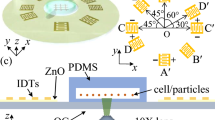Abstract
We proposed a new bacteria patterning method on the restricted region of microbeads, using the submerged property of polystyrene microbeads on various concentrations of agarose gel. Moreover, we fabricated a bacterial microrobot using attenuated Salmonella typhimurium through the new patterning methods. We controlled the submerged degree of polystyrene microbeads through the regulation of the hardness of the agarose gel. The polystyrene microbeads on agarose gel were transferred onto a poly-dimethylsiloxane (PDMS) surface for easy manipulation of the microbeads. Then, we treated the polystyrene microbeads on the PDMS surface with antibacterial adherent factors, such as O2 plasma and bovine serum albumin (BSA). The Salmonella typhimurium was attached to the entire surface of the untreated polystyrene microbeads, whereas Salmonella typhimurium were only attached to the restricted surface region of the treated polystyrene microbeads through the proposed patterning method. The bacteria-attached microbeads gain motility by the propulsion of the attached bacteria, and the selective-bacteria-attached microbeads showed enhanced motility. Compared with whole-bacteria-attached polystyrene microbeads (1.74 ± 1.62 μm/s), the selective bacteria-attached polystyrene microbeads, using O2 plasma and BSA, showed 9.18 ± 1.88 μm/s and 14.65 ± 8.66 μm/s faster moving velocities, respectively. Through the results, we expected that the proposed patterning methodology of microbeads could contribute to the development of biomedical bacterial microrobots.





Similar content being viewed by others
References
J.J. Abbott, Z. Nagy, F. Beyeler, B.J. Nelson, IEEE Robot. Autom. Mag. 14, 92 (2007)
B. Behkam, M. Sitti, Proc. IEEE Eng. Med. Biol. Soc. 1, 2421 (2006)
B. Behkam, M. Sitti, Appl. Phys. Lett. 93, 223901 (2008)
H.C. Berg, Annu. Rev. Biochem. 72, 19 (2003)
S. Bouadiat, C. Berendsen, P. Thomsen, S.G. Petersen, A. Wolff, J. Jonsmann, Lab Chip 4, 632 (2004)
J.D. Bronzino, The Biomedical Engineering Handbook, 3rd edn. (Taylor & Francis, 2006)
A. Cavalcanti, R.A. Freitas Jr., IEEE Trans. Nanobiosci. 4, 133 (2005)
A. Cerf, C. Vieu, INTECH Chapter 22, 447 (2010)
H. Choi, J. Choi, G. Jang, J. Park, S. Park, Smart Mater. Struct. 18, 055007 (2009)
N. Darnton, L. Turner, K. Breuer, H.C. Berg, Biophys. J. 86, 1863 (2004)
M. Eisenbach, Encyclopedia of Life Sciences 1 (2001)
S. Floyd, C. Pawashe, M. Sitti, IEEE Trans. Robot. 25, 1332 (2009)
R.A. Freitas Jr., Biotechnology 26, 441 (1998)
H.M. Haruff, J. Munakata-Marr, D.W.M. Marr, Biointerfaces 27, 189 (2003)
A. Hejazi, F.R. Falkiner, J. Med. Microbiol. 46, 903 (1997)
J.R. Howse, R.A.L. Jones, A.J. Ryan, T. Gough, R. Vafabakhsh, R. Golestanian, Phys. Rev. Lett. 99, 048102 (2007)
J.F. Jones, J.D. Feick, D. Imoudu, N. Chukwumah, M. Vigeant, D. Velegol, Appl. Environ. Microbiol. 69, 6515 (2003)
C.T. Lefèvre, A. Bernadac, K. Yu-Zhang, N. Pradel, L. Wu, Environ. Microbiol. 11, 1646 (2009)
W. Lin, J. Li, Y. Pan, Appl. Environ. Microbiol. 78, 668 (2012)
M.C.M. Loosdrecht, J. Lyklema, W. Norde, A.J.B. Zehnder, Microb. Ecol. 17, 1 (1989)
S. Martel, Proc. Int. Conf. Microtech. Med. Biol. 89 (2006)
S. Martel, M. Mohammadi, O. Felfoul, Z. Lu, P. Pouponneau, Int. J. Robot. Res. 28, 571 (2009)
J. Min, V.H. Nguyen, H. Kim, Y. Hong, H. Choy, Nat. Protoc. 3, 629 (2008)
S. Park, H. Bae, J. Kim, B. Lim, J. Park, S. Park, Lab Chip 10, 1706 (2010)
A.A.G. Requicha, IEEE Spec. Issue Nanoelectron. Nanoprocess. 91, 1922 (2003)
B. Rowan, M.A. Wheeler, R.M. Crooks, Langmuir 18, 9914 (2002)
R.M. Ryan, J. Green, C.E. Lewis, Bioessays 28, 84 (2006)
M.S. Sakar, E.B. Steager, D. Kim, A.A. Julius, M. Kim, V. Kumar, G.J. Pappas, Int. J. Robot. Res. 30, 647 (2008)
N.N. Sharma, R.K. Mittal, Int. J. Smart Sens. Intell. Syst. 1, 87 (2008)
M. Siegel, IEEE Instrum. Meas. Technol. Conf. 303 (2001)
M. Sitti, Proceedings of the 2004 American Control Conference 1 (2004)
E. Steager, C.B. Kim, J. Patel, S. Bith, C. Naik, L. Reber, M.J. Kim, Appl. Phys. Lett. 90, 263901 (2007)
E.B. Steager, M.S. Sakar, D.H. Kim, V. Kumar, G.J. Pappas, M.J. Kim, J. Micromech. Microeng. 21, 035001 (2011)
A. Zita, M. Hermansson, Appl. Environ. Microbiol. 60, 3041 (1994)
Acknowledgments
This research was supported by the Future Pioneer R&D program through the National Research Foundation of Korea, funded by the Ministry of Education, Science, and Technology (2010-0002240).
Author information
Authors and Affiliations
Corresponding authors
Electronic supplementary material
Below is the link to the electronic supplementary material.
S 1
Confocal microscopic Z stack images of S. typhimurium attachment on untreated PS microbead surfaces. (Scale bars = 20 μm). (JPEG 1992 kb)
S 2
Confocal microscopic time lapse images of S. typhimurium attachment on untreated PS microbead surfaces. (Scale bars = 20 μm). (JPEG 2013 kb)
S 3
Mean squared displacements of Untreated microbead, BSA-coated microbead and O2 plasma-exposed PS microbead. Stochastic function was fitted to this data set (JPEG 115 kb)
(AVI 1163 kb)
(AVI 1037 kb)
(AVI 773 kb)
(AVI 481 kb)
(AVI 433 kb)
Rights and permissions
About this article
Cite this article
Park, S.J., Bae, H., Ko, S.Y. et al. Selective bacterial patterning using the submerged properties of microbeads on agarose gel. Biomed Microdevices 15, 793–799 (2013). https://doi.org/10.1007/s10544-013-9765-9
Published:
Issue Date:
DOI: https://doi.org/10.1007/s10544-013-9765-9




